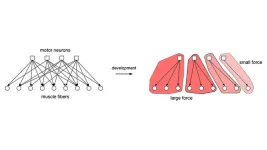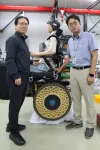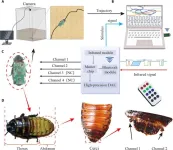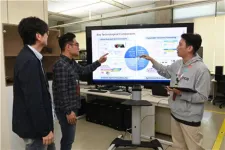(Press-News.org) Early detection of breast cancer through mammography screening continues to save lives. However, abnormal findings on mammograms can lead to women being recalled for additional imaging and biopsies, many of which turn out to be “false positives,” meaning they do not result in a cancer diagnosis. False positives can also have financial implications for patients and cause significant emotional anxiety.
A major, new study led by the UC Davis Comprehensive Cancer Center has found that women who received a false-positive result that required additional imaging or biopsy were less likely to return for that follow-up screening.
The research was published in the Annals of Internal Medicine on Sept. 3. It analyzed data on more than 3.5 million screening mammograms nationwide performed between 2005-2017 on over 1 million patients aged 40 to 73.
“The finding raises concerns about the potential unintended consequence of false-positive results, where women may avoid screening mammograms in the future,” said lead author Diana Miglioretti, cancer center researcher and chief of the Division of Biostatistics at UC Davis.
Findings are worrisome to researchers
The study found that 77% of women with a negative result from a mammogram returned for subsequent screening. But this percentage dropped to 61% after a false-positive finding requiring another mammogram in six months to confirm the results and 67% if a biopsy was recommended. The impact was even more pronounced for women who received false-positive results on two consecutive mammograms recommending short-interval follow-up—only 56% returned their next screening mammogram.
The high rate of women who don’t return for future screening is concerning to the research team.
“It is important for women with false-positive results to continue screening every one to two years,” Miglioretti said, “Having a false-positive result, especially if it results in a diagnosis of benign breast disease, is associated with an increased risk of being diagnosed with breast cancer in the future.”
The research also showed that Asian and Hispanic/Latinx women were the least likely to return for future screening mammograms after a false positive result, which may contribute to existing health disparities.
False-positive results are common, especially among younger women. They occur in 10-12% of mammograms in women 40-49 years of age. After 10 years of annual screenings, 50-60% of women can expect at least one false-positive and 7-12% at least one false-positive with a biopsy recommendation.
“It’s important to understand that most women recalled for additional imaging due to a finding on a screening mammogram do not have breast cancer,” Miglioretti said. “They should try not to be worried if they are recalled for additional work-up. it is a normal and common part of the screening process.”
It is important for women to understand that about 10% of the time, additional imaging is necessary to get a better look at a finding on a screening mammogram.
Steps to consider
Miglioretti said women who feel anxious while waiting for their screening mammography results might consider requesting an on-the-spot interpretation of their mammogram. Some facilities provide this service along with same-day diagnostic work-up, if there is a suspicious finding.
She said it is also important for physicians to carefully explain false-positive results to their patients to reassure them that the result was negative and stress the importance of continued screening.
Other authors: Linn Abraham and Erin J. A. Bowles, Kaiser Permanente Washington Health Research Institute; Brian L. Sprague, University of Vermont; Christoph I. Lee, University of Washington; Michael C. S. Bissell, Picnic Health; Thao-Quyen H. Ho, University Medical Center, Ho Chi Minh city, Vietnam; Louise M. Henderson, University of North Carolina; Rebecca A. Hubbard, University of Pennsylvania; Anna N. A. Tosteson, Dartmouth; Karla Kerlikowske, University of California, San Francisco.
Funding:
National Cancer Institute P01CA154292, R01CA266377, R50CA211115; National Institute of General Medicine Science U54GM115516; Residual class settlement funds in the matter of April Krueger vs. Wyeth, Inc.
END
False-positive mammograms discourage some women from future screenings
New UC Davis study says false positives are all the more reason to keep on schedule with mammograms
2024-09-02
ELSE PRESS RELEASES FROM THIS DATE:
The nervous system’s matchmaker
2024-09-02
When you ask a rideshare app to find you a car, the company’s computers get to work. They know you want to reach your destination quickly. They know you’re not the only user who needs a ride. And they know drivers want to minimize idle time by picking up someone nearby. The computer’s job, says Cold Spring Harbor Laboratory Associate Professor Saket Navlakha, is to pair drivers with riders in a way that maximizes everyone’s happiness.
Computer scientists like Navlakha call this bipartite matching. It’s the same task handled by systems pairing organ donors with transplant candidates, medical students with residency ...
Open Wide: Human Mouth Bacteria Reproduce through Rare Form of Cell Division
2024-09-02
By Emily Greenhalgh
One of the most diverse ecosystems on the planet is closer than you think — right inside your mouth. Your mouth is a thriving ecosystem of more than 500 different species of bacteria living in distinct, structured communities called biofilms. Nearly all of these bacteria grow by splitting [or dividing] into two, with one mother cell giving rise to two daughter cells.
New research from the Marine Biological Laboratory (MBL) and ADA Forsyth uncovered an extraordinary mechanism of cell division in Corynebacterium matruchotii, one of the most common bacteria living in dental plaque. ...
KIMM develops wheel that alters stiffness in real time based on situation
2024-09-02
A new technology for wheels and mobile systems, necessary for overcoming various obstacles in daily life such as stairs or rocks by adjusting the stiffness of the wheel in real time, has been developed for the first time in the world. This noble technology is anticipated to find wide applications in various moving vehicles equipped with wheels, where overcoming terrain obstacles is essential.
The Korea Institute of Machinery and Materials (President Seog-Hyeon Ryu, hereinafter referred to as KIMM), an institute under the jurisdiction of the ...
Blood stem cell breakthrough could transform bone marrow transplants
2024-09-02
Melbourne researchers have made a world first breakthrough into creating blood stem cells that closely resemble those in the human body. And the discovery could soon lead to personalised treatments for children with leukaemia and bone marrow failure disorders.
The research, led by Murdoch Children’s Research Institute (MCRI) and published in Nature Biotechnology, has overcome a major hurdle for producing human blood stem cells, which can create red cells, white blood cells and platelets, that closely match those in the human embryo.
MCRI Associate Professor Elizabeth Ng said the team had made a significant discovery in human blood stem ...
Rare genetic variants linked to bicuspid aortic valve disease in young adults identified by UTHealth Houston researchers
2024-09-02
Genetic variants linked to a rare form of bicuspid aortic valve disease that affects young adults and can lead to dangerous and potentially life-threatening aortic complications have been identified by researchers at UTHealth Houston.
The study was published today in the American Journal of Human Genetics.
“We previously found that young individuals who present due to early onset thoracic aortic dissections are more likely to have bicuspid aortic valves and more likely to have rare variants in bicuspid aortic valve-associated genes,” said Siddharth Prakash, MD, PhD, co-principal investigator of the study and associate professor of medical ...
Locomotion control of cyborg insects by charge-balanced biphasic electrical stimulation
2024-09-02
A research paper by scientists at Beijing Institute of Technology proposed a universal system for remote signal output control using infrared signals.
The new research paper, published on Jul. 05 in the journal Cyborg and Bionic Systems, proposed a system that integrates high-precision digital-to-analog converters capable of generating customized waveform electrical stimulation signals within defined ranges. This enhances the accuracy of locomotion control in cyborg insects while maintaining real-time control and dynamic parameter adjustment. The proposed system is verified by experiments.
The integration of electronic stimulation devices with insects in ...
Depressed adolescents twice as likely to vape
2024-09-02
A study on vaping behaviour among Australian high school students has found those who reported severe depressive symptoms were over twice as likely to have tried e-cigarettes, compared to those reporting no depressive symptoms.
Data showed overall higher e-cigarette use among those with poorer mental health, including severe depressive symptoms, moderate and high stress, and low wellbeing.
The findings show a critical need for effective mental health support at the same time as vaping prevention during early adolescence -- when these issues first emerge.
The researchers surveyed over ...
Helping public decision-making with AI-based policy intelligence system
2024-09-02
Korean researchers are pushing for a new AI-based policy intelligence research project that can assist the public decision-making and policy execution of domestic and foreign local governments.
Electronics and Communications Research Institute (ETRI) announced on July 1 that they have decided to establish a cooperative system with the International Institute for Applied Systems Analysis (IIASA)1) to conduct further research regarding the development of an AI policy intelligence system that can assist public policy decision-making.
1) International Institute for Applied Systems Analysis (IIASA): An independent international research institute located ...
Pulmonary vein isolation vs sham intervention in symptomatic atrial fibrillation
2024-09-02
About The Study: Pulmonary vein isolation resulted in a statistically significant and clinically important decrease in atrial fibrillation burden at 6 months, with substantial improvements in symptoms and quality of life, compared with a sham procedure.
Corresponding Authors: To contact the corresponding authors, email Rick A. Veasey, MD, (rick.veasey@nhs.net) and Rajdip Dulai, MBBS, (rajdip.dulai.21@ucl.ac.uk)
To access the embargoed study: Visit our For The Media website at this link https://media.jamanetwork.com/
(doi:10.1001/jama.2024.17921)
Editor’s ...
Lesion-level effects of LDL-C–lowering therapy in patients with acute myocardial infarction
2024-09-02
About The Study: At the lesion level, very intensive lipid-lowering therapy induced substantially greater percent atheroma volume regression than described in previous vessel-level analyses. Compared with statin therapy alone, alirocumab treatment was associated with greater enlargement of the lesion minimum lumen area and more frequent transition of presumably high-risk plaque phenotypes into more stable, less lipid-rich plaque phenotypes.
Corresponding Author: To contact the corresponding author, Lorenz ...
LAST 30 PRESS RELEASES:
Numbers in our sights affect how we perceive space
SIMJ announces global collaborative book project in commemoration of its 75th anniversary
Air pollution exposure and birth weight
Obstructive sleep apnea risk and mental health conditions among older adults
How talking slows eye movements behind the wheel
The Ceramic Society of Japan’s Oxoate Ceramics Research Association launches new international book project
Heart-brain connection: international study reveals the role of the vagus nerve in keeping the heart young
Researchers identify Rb1 as a predictive biomarker for a new therapeutic strategy in some breast cancers
Survey reveals ethical gaps slowing AI adoption in pediatric surgery
Stimulant ADHD medications work differently than thought
AI overestimates how smart people are, according to HSE economists
HSE researchers create genome-wide map of quadruplexes
Scientists boost cell "powerhouses" to burn more calories
Automatic label checking: The missing step in making reliable medical AI
Low daily alcohol intake linked to 50% heightened mouth cancer risk in India
American Meteorological Society announces Rick Spinrad as 2026 President-Elect
Biomass-based carbon capture spotlighted in newly released global climate webinar recording
Illuminating invisible nano pollutants: advanced bioimaging tracks the full journey of emerging nanoscale contaminants in living systems
How does age affect recovery from spinal cord injury?
Novel AI tool offers prognosis for patients with head and neck cancer
Fathers’ microplastic exposure tied to their children’s metabolic problems
Research validates laboratory model for studying high-grade serous ovarian cancer
SIR 2026 delivers transformative breakthroughs in minimally invasive medicine to improve patient care
Stem Cell Reports most downloaded papers of 2025 highlight the breadth and impact of stem cell research
Oxford-led study estimates NHS spends around 3% of its primary and secondary care budget on the health impacts of heat and cold in England
A researcher’s long quest leads to a smart composite breakthrough
Urban wild bees act as “microbial sensors” of city health.
New study finds where you live affects recovery after a hip fracture
Forecasting the impact of fully automated vehicle adoption on US road traffic injuries
Alcohol-related hospitalizations from 2016 to 2022
[Press-News.org] False-positive mammograms discourage some women from future screeningsNew UC Davis study says false positives are all the more reason to keep on schedule with mammograms




